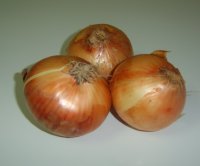

| Materials | Methods of preparation | How to use | Plant pests |
| Onion bulb extract 1 (Vijayalakshmi, et.al., 1999: pp. 30-32) 85 grams of chopped onion 50 ml of mineral oil (kerosene) 10 ml of soap 450 ml of water Strainer Bottle container |
Add chopped onion to kerosene. Allow this mixture to stand for 24 hours. Add water and stir-in the soap. Store in bottle container. |
Dilute 1 part of the emulsion with 19 parts of water (for example, 50 ml of emulsion to 950 ml of water). Shake well before spraying. Spray thoroughly on the infested plant, preferably early in the morning. |
Whiteflies |
| Onion bulb extract 2 (Stoll, 2000: p. 172) 1 kg of bulb onions 1 liter of water Cooking pot Pail Strainer |
In a pot, bring 1 liter of water to boil. Chop the onions, then place in a covered container. Pour the boiling water into the container. Let it stand for 24 hours. |
Dilute the 1 liter extract with 10 liters of water. Spray thoroughly on the infested plant, preferably early in the morning or late afternoon. | Ants Scales Spider mites Thrips |
| Onion bulb extract 3 (Stoll, 2000: p. 223) 50 g of bulb onion 1 liter distilled water Pail Strainer |
Finely chop the onion. Add to water. Mix well. Strain. |
Spray thoroughly on the infested plant, preferably early in the morning or late afternoon. | Alternaria Anthracnose Fusarium wilt Fungal leaf blight |